Marrying Vega and Zen: The AMD Ryzen 5 2400G Review
by Ian Cutress on February 12, 2018 9:00 AM ESTBenchmarking Performance: CPU Encoding Tests
One of the interesting elements on modern processors is encoding performance. This includes encryption/decryption, as well as video transcoding from one video format to another. In the encrypt/decrypt scenario, this remains pertinent to on-the-fly encryption of sensitive data - a process by which more modern devices are leaning to for software security. Video transcoding as a tool to adjust the quality, file size and resolution of a video file has boomed in recent years, such as providing the optimum video for devices before consumption, or for game streamers who are wanting to upload the output from their video camera in real-time. As we move into live 3D video, this task will only get more strenuous, and it turns out that the performance of certain algorithms is a function of the input/output of the content.
All of our benchmark results can also be found in our benchmark engine, Bench.
7-Zip 9.2: link
One of the freeware compression tools that offers good scaling performance between processors is 7-Zip. It runs under an open-source licence, is fast, and easy to use tool for power users. We run the benchmark mode via the command line for four loops and take the output score.
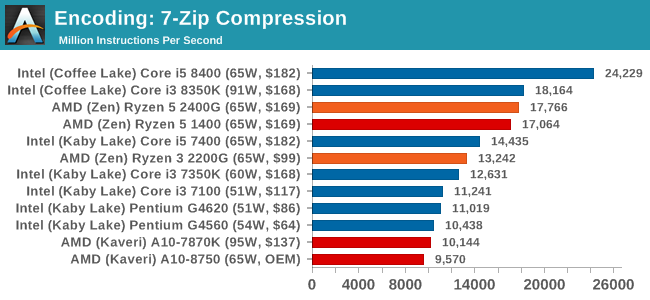
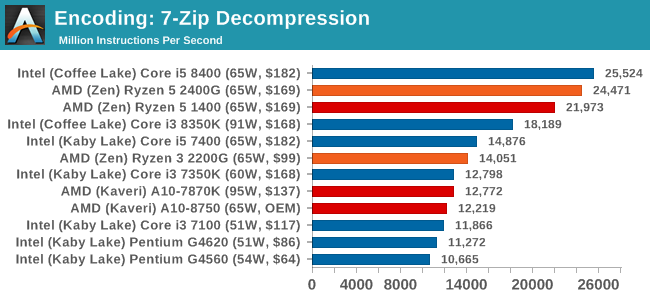
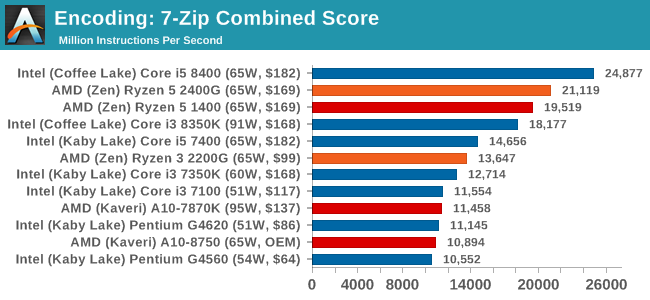
7-zip gives two contrasting stories here. For compression, full cores are needed to get the best performance, with frequency helping as well. However, for decompression, the extra threads help a lot. The combined result looks more like the decompression score, with the Ryzen 5 2400G sitting between the six-core Core i5-8400 and the quad-core Core i3-8350K.
WinRAR 5.40: link
For the 2017 test suite, we move to the latest version of WinRAR in our compression test. WinRAR in some quarters is more user friendly that 7-Zip, hence its inclusion. Rather than use a benchmark mode as we did with 7-Zip, here we take a set of files representative of a generic stack (33 video files in 1.37 GB, 2834 smaller website files in 370 folders in 150 MB) of compressible and incompressible formats. The results shown are the time taken to encode the file. Due to DRAM caching, we run the test 10 times and take the average of the last five runs when the benchmark is in a steady state.
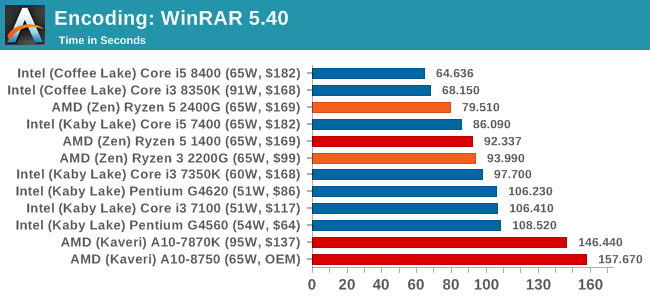
WinRAR is a good scaler with cores, frequency, and memory performance. The eight threads and DDR4-2933 contributes a good amount to the performance here, especially in light of where AMD was. The jump from the Ryzen 5 1400 to the 2400G is also noticable, due to the uptick in frequency and memory speed. The high single-thread performance of the Intel cores still wins out, however.
AES Encoding
Algorithms using AES coding have spread far and wide as a ubiquitous tool for encryption. Again, this is another CPU limited test, and modern CPUs have special AES pathways to accelerate their performance. We often see scaling in both frequency and cores with this benchmark. We use the latest version of TrueCrypt and run its benchmark mode over 1GB of in-DRAM data. Results shown are the GB/s average of encryption and decryption.
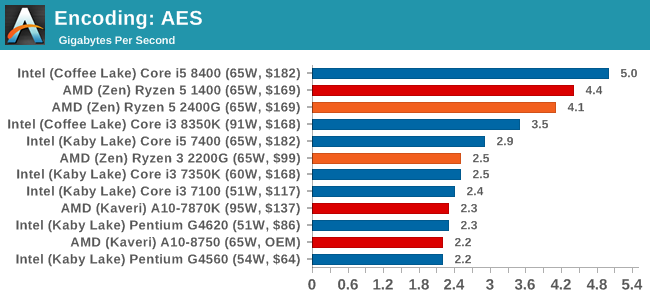
HandBrake v1.0.2 H264 and HEVC: link
As mentioned above, video transcoding (both encode and decode) is a hot topic in performance metrics as more and more content is being created. First consideration is the standard in which the video is encoded, which can be lossless or lossy, trade performance for file-size, trade quality for file-size, or all of the above can increase encoding rates to help accelerate decoding rates. Alongside Google's favorite codec, VP9, there are two others that are taking hold: H264, the older codec, is practically everywhere and is designed to be optimized for 1080p video, and HEVC (or H265) that is aimed to provide the same quality as H264 but at a lower file-size (or better quality for the same size). HEVC is important as 4K is streamed over the air, meaning less bits need to be transferred for the same quality content.
Handbrake is a favored tool for transcoding, and so our test regime takes care of three areas.
Low Quality/Resolution H264: Here we transcode a 640x266 H264 rip of a 2 hour film, and change the encoding from Main profile to High profile, using the very-fast preset.
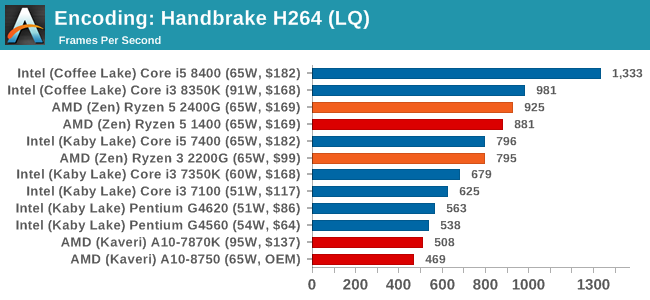
High Quality/Resolution H264: A similar test, but this time we take a ten-minute double 4K (3840x4320) file running at 60 Hz and transcode from Main to High, using the very-fast preset.
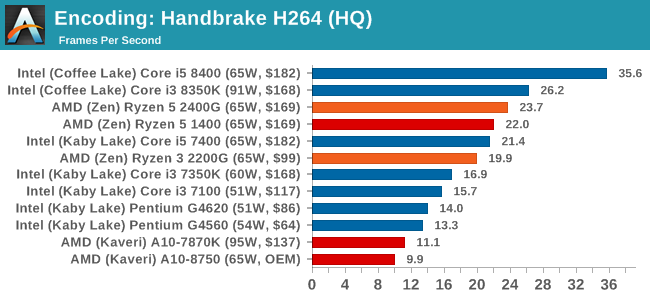
HEVC Test: Using the same video in HQ, we change the resolution and codec of the original video from 4K60 in H264 into 4K60 HEVC.
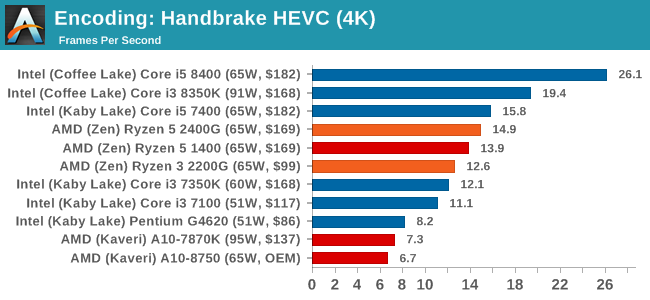










177 Comments
View All Comments
sonicmerlin - Tuesday, February 13, 2018 - link
Now if only AMD had a competent GPU arch. The APU performance could be given a huge boost with Nvidia’s techdr.denton - Thursday, February 15, 2018 - link
They do. It's called Vega. Very efficient in mid- to low range and compute, and if I'm not mistaken that's where the money is. Highend gaming is just wi**ie waving for us geeks.HStewart - Tuesday, February 13, 2018 - link
Check out performance of up and coming i8809G with Vega Graphics compare to Ryzen 7http://cpu.userbenchmark.com/Compare/Intel-Core-i7...
Keep in mine this is a mobile chips - this is new mobile chips is quite powerful - I thinking of actually getting one - only big concern is compatibility with Vega chip.
haplo602 - Wednesday, February 14, 2018 - link
the i8809G is a desktop chip, 100W TDP ....hansmuff - Tuesday, February 13, 2018 - link
Any idea where I could buy the MSI B350I Pro AC? I have searched every retailer I've ever bought from and can not find the damn thing. I'm hoping it can run a 2400G out of the box, at least to update to the newest BIOS.Dragonstongue - Tuesday, February 13, 2018 - link
they REALLY should not have cut back the L3 cache SO MUCH...beyond that, truly are amazing for what they are...they should have also made a higher TDP version such as 125-160w so they could cram more cpu cores or at very least a more substantial graphics portion and not limit dGPU access to 8x pci-e (from what I have read)Graphics cards and memory are anything but low cost.
2200 IMO is "fine" for what it is, the 2400 should have had at least 4mb l3 cache (or more) then there should have been "enthusiast end" with the higher TDP versions so they could more or less ensure someone trying to do it "on a budget" really would not have to worry about getting anything less than (current) RX 570-580 or 1060-1070 level.
many cpu over the years (especially when overclocked) had a 140+w TDP, they could have and should have made many steps for their Raven Ridge and not limit them so much..IMO...they could have even had a frankenstein like one that has a 6pin pci-e connector on it to feed more direct power to the chip instead of relying on the socket alone to provide all the power needed (at least more stable power)
AM4 socket has already been up to 8 core 16 thread, and TR what 16 core 32 thread says to me the "chip size" has much more room available internally to have a bigger cpu portion and/or a far larger GPU portion, now, if they go TR4 size, TR as it is already has 1/2 of it "not used" this means they could "double up" the vega cores in it to be a very much "enthusiast grade" APU, by skimping cost on the HBM memory and relying on the system memory IMO there is a vast amount of potential performance they can capture, not to mention, properly designed, the cooling does not really become an issue (has not in the past with massive TDP cpu afterall)
anyways..really is very amazing how much potency they managed to stuff into Raven Ridge, they IMO should not have "purposefully limited it" especially on the L3 cache amount, 2mb is very limiting as far as I am concerned especially when trying to feed 4 core 8 thread at 65w TDP alojng with the gpu portion.
Either they are asking a bit much for the 2400g or, they are asking enough they just need to "tweak" a bit more quickly to make sure it is not bottlenecking itself for the $ they want for it ^.^
either way, very well done....basically above Phenom II and into Core i7 level performance with 6870+ level graphics grunt using much less power...amazing job AMD...Keep it up.
SaturnusDK - Wednesday, February 14, 2018 - link
Well done AMD. Well done.Both these APUs are extremely attractive. The R5 just screams upgradable. You get a very capable 4 core / 8 thread CPU packaged with an entry level dGPU for less than the competition charges for the CPU (with abyssmal iGPU) alone. In the current market with astronomical, even comical, dGPU prices this is a clear winner for anyone wanting to build a powerful mid-tier system but doesn't have the means to fork out ridiculous cash for higher tier dGPU now.
The R3 scream HTPC or small gaming box. A good low end CPU paired with a bare bones but still decently performing iGPU. Add MB, RAM, PSU, and HDD/SSD and you're good to go. I imagine these will sell like hot cakes in markets with less overall GDP and in the brick'n'mortar retail market.
The question is now. Is Intel ever going to produce a decent iGPU for the low end market? They've had plenty of time to do so but before Ryzen, AMD APUs just wasn't that attractive. Now though, you really have to think hard for a reason to justify buying a low end Intel CPU at all.
yhselp - Wednesday, February 14, 2018 - link
"Now with the new Ryzen APUs, AMD has risen that low-end bar again."You had to do it. I understand. And thank you.
dr.denton - Thursday, February 15, 2018 - link
<3Hifihedgehog - Wednesday, February 14, 2018 - link
I have been doing some digging and found that although current-generation AM4 motherboards lack formal HDMI 2.0 certification, just like many HDMI 1.4 cables will pass an HDMI 2.0 signal seamlessly without a hitch, the same appears to be the case for these boards whose HDMI traces and connectors may indeed be agnostic to the differences, if any. Could you do a quick test to see if HDMI 2.0 signals work for the Raven Ridge APUs on the AM4 motherboards you have access to? For further reference on the topic, see this forum thread “Raven Ridge HDMI 2.0 Compatibility — AM4 Motherboard Test Request Megathread” at SmallFormFactor.